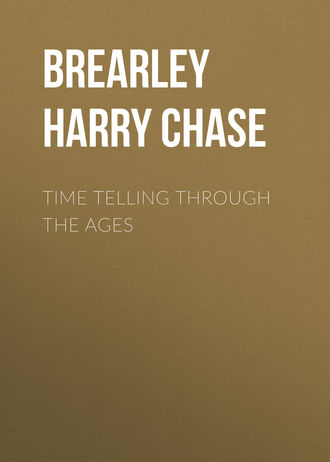 полная версия
полная версияTime Telling through the Ages

Hour-Glass – A device for measuring hours. It has two cone-shaped superimposed glass globes connected at their apexes through a small opening. The glass contains just that quantity of sand, or mercury, as will flow in one hour through the opening from the upper globe to the lower. When it has run through the glass is reversed. See: Sand Glass. Like the sun-dial and the clepsydra, the hour-glass is older than we know. Its use probably followed close upon that of the clepsydra, or may even have preceded it in dry countries like Egypt and Babylonia, where sand was all about and water was not a thing to waste. Of its original forms there is no authentic record. Dry sand does not, like water, run faster or slower through a given opening according to the pressure from above; its rate is the same whether the upper glass is full or nearly empty. Also the hour-glass never needs to be refilled, but only to be reversed, and the same sand used over and over again. On the other hand, its convenience diminished as its size increased. It was too clumsy for use if made large enough to run without attention for more than an hour or two; and in so large a glass there was more danger that the sand, however dry, might cake up and stop running. It must somehow have been transparent for convenient reading, because sand can register the time only by its flow: it cannot be made to raise a float or work a pointer. But the Egyptians very early learned to manufacture glass, and there were other substances. A legend ascribes the invention of the sand-glass to Luitprand, a Carthusian monk of the Eighth Century A. D. But this, if there is any truth in the story at all, must have been some improvement or reinvention after the forgetfulness of the Dark Ages. The device is plainly shown in Greek sculptures antedating the Christian era. Nowadays the sand-glass has pretty much disappeared, except as a kitchen timepiece for boiling eggs and the like.
Hour Hand – The hand of a watch or clock which indicates the hour: for long after clocks were first made, the only hand provided.
Hour Wheel – The wheel which revolves on the minute wheel or cannon pinion and carries the hour hand.
Howard, Edward – Born at Hingham, Mass., October 6, 1813. Having served a regular apprenticeship in clockmaking he entered into partnership with D. P. Davis, at the age of 29, to make clocks. He was a clever mechanic and invented many pieces of mechanism, among them the swing rest. In 1849 he and Davis with A. L. Dennison and others organized the American Horologe Company for the manufacture of watches by machinery, and with the parts interchangeable – the American principle of today. Though they were not financially successful the American watch industry owes its present day success largely to this beginning by Edward Howard and Aaron L. Dennison. The first company developed into the present Waltham Company, and later Mr. Howard established the E. Howard Co., at Roxbury, but severed his connection with them in 1882 and retired from business. He died March 5, 1904.
Huggeford, Ignatius – An English watchmaker, one of whose watches was used to defraud Facio of his patent on the use of jewels in watches. See Facio, Nicolas.
Hunter, or Hunting-Case – A watch case which has a solid metal cover over the dial.
Hunter, George – Identified with watchmaking in America since about 1860 – in the Waltham and Elgin Companies. He was general superintendent of the latter from 1872 to 1903, after which he was made consulting superintendent.
Huyghens, Christian – A celebrated Dutch astronomer and mathematician born at The Hague, April 14, 1629. Although the honor is claimed for Richard Harris in 1641 and for Vincent Galileo in 1649 it seems historically established that Huyghens in 1657 was the first to apply to clocks the theory of the isochronism of the pendulum which the great Galileo had discovered. In 1669 he published his important work, "Horologium Oscillatorium." In 1673 he made the first clock with concentric hour and minute hands. He died in 1695.
Huyghens' Checks – The arc of a swinging pendulum is a segment of a circle. For perfect isochronism it should be a cycloidal segment. To accomplish this Huyghens fixed curved brass pieces called checks for the cord to strike against but he caused thereby a greater error than he remedied. This end was later accomplished by suspending the pendulum by means of a flat steel strip instead of a cord; a device credited to Robert Hooke.

Hypocycloid – A curve generated by any point in the circumference of a circle which is rolled on the inner side of the circumference of a larger fixed circle.
Idler, Idle Wheel, or Intermediate Wheel – A toothed wheel used to connect driver and follower wheels so that both shall rotate in the same direction.
Impulse – The push transmitted to the pallet by the escape wheel.
Impulse Pin – The jewel pin – usually a ruby – on the table roller of the lever escapement, which playing into the fork of the lever transmits the impulse to the balance.
Independent Center-Seconds – A watch peculiarly adapted to the use of the medical profession. It carries on a separate train a long seconds hand in addition to the hands of the ordinary watch which can be stopped without stopping the watch.
Independent Seconds – A watch whose seconds hand is driven by a separate train.
Ingersoll, Charles Henry – Secretary, Treasurer and General Manager of Robt. H. Ingersoll & Brothers., watch manufacturers, of New York City. Born at Delta, Eaton County, Michigan, October 29, 1865, a son of Orville Boudinot and Mary Elizabeth (Beers) Ingersoll. At the early age of fifteen years he left home and went to New York City, where he entered the employ of his brother, Robert H., who was then engaged in the business of manufacturing rubber stamps. Since 1880 he has been continuously associated with his brother in various business enterprises and in the direction and management of the Ingersoll organization. Married Eleanor Ramsey Bond of Brooklyn, New York, July 5, 1898. Residence, South Orange, New Jersey.
Ingersoll, Robert Hawley – Founder and President of Robt. H. Ingersoll & Brothers., watch manufacturers, of New York City. Born December 26, 1859, of Orville Boudinot and Mary Elizabeth (Beers) Ingersoll, at Delta, Eaton County, Michigan, he received his early education in the public schools of his native town. In 1879, at the age of nineteen years, he came to New York City, and in the following year engaged in the business of manufacturing rubber stamps; later, he established a mail order business, selling various "dollar" specialties and novelties. While engaged in this business he conceived the idea and in 1892 commenced the manufacture of the "dollar watch," since which time over 50,000,000 watches have been produced and sold by the Ingersoll organization. Married June 20, 1904, to Roberta Marie Bannister of Green Bay, Wisconsin. Residence, Oyster Bay, Long Island.
Ingersoll, William Harrison – Marketing Manager of Robert H. Ingersoll & Brothers., watch manufacturers, New York City. Born March 22, 1879, near Lansing, Michigan. He received a grammar and high school education and three years' technical training for electrical engineer. In 1901 he entered business in the retail sporting goods store of Robt. H. Ingersoll & Brothers. in New York City and was soon placed in charge of the Ingersoll watch advertising, over which he exercised close supervision ever since, except for two periods prior to 1908, when he sought and gained valuable outside experience in other capacities, such as salesman and as manager of the Ingersoll watch business in Canada; he then became advertising manager, later sales and advertising manager and then general marketing manager for developing all markets of all countries of the world for the Ingersoll products. Active in the promotion of advertising research, Mr. Ingersoll was one of the founders of Truth in Advertising work, assisted in establishing a Fellowship in Advertising Research at Columbia University, New York City, and has written and lectured extensively on salesmanship, advertising, marketing and related subjects. His residence is at Maplewood, New Jersey.
Ingold, Franz – A Swiss watchmaker who had the idea of making watch parts on the interchangeable plan long before it was put into practice anywhere. He was ill-received by labor and capital alike when he presented his plans in France, England, and America. In England he was nearly mobbed. In 1842-43 he obtained patents on some machinery in this line, but the machines were clumsy and for the most part impracticable. There has been a tendency to credit Ingold as the source of Dennison's ideas on this subject, though Dennison says he never heard of Ingold until after he had started manufacturing.
Intercalary – Introduced or added arbitrarily to a calendar; for example, the 29th day of February is an intercalary day.
Interchangeability – America's greatest contribution to watchmaking has been the standardizing of parts and the manufacturing of each of them, exactly alike, in great quantities. So that repairing an American watch is largely a matter of obtaining a new part similar to the damaged one, and simply putting it in place.
Invar – An alloy of nickel and steel claimed to be non-magnetizable. Used for certain parts of watches at the time when non-magnetizable watches were desirable. Invar is practically non-expansible when the nickel in it is about 37 %.
Isochronism – That property of a pendulum or balance spring by virtue of which its vibrations, of whatever length, are all made in exactly equal periods of time.
Jacks; or Jack o' the Clock – Figures on the old turret clocks which automatically struck the hours. They preceded dials tho were usually left when the dials were added. There are Jacks on the clock at St. Mary Steps, Exeter; Norwich Cathedral, South Aisle; and St. Dunstan's in Fleet St., among others.

Jacquemarts – Figures of man and woman which struck the hours on the clock set up by Philip of Burgundy at Dijon, prior to 1370. G. Peignot says they are so named from Jacquemart, a clock maker of Lille, employed by the Duke of Burgundy in 1442. The lack of co-ordination in the dates tends to controvert the claim.
Jerome, Chauncey – Originator of the one-day brass clock movement which enormously increased the American clock business and opened a market for American clocks in Europe. Born in Canaan, Connecticut, in 1793. Established the Jerome Clock Company at New Haven, Connecticut. This was the predecessor of The New Haven Clock Company.
Jewelled – Fitted with precious stones to diminish wear as distinguished from precious stones for ornament. In the best watches ruby and sapphire are used. In lower grade watches quartz, amethyst and garnet.
Jewels – Used in watches as bushings at the ends of pivots and in other places which sustain much wear. They:
1. Provide smooth bearings for the pivots.
2. Obviate corrosion.
3. Reduce the wear from abrasion.
Sapphire is the best of the jewels in use and ruby second. Chrysolite is also used and garnet, tho the latter is too brittle for most service. This use of jewels was invented by Nicolas Facio – a Swiss watchmaker about 1705.
Julian Period – A period of 7980 years obtained by multiplying 28, 19 and 15 – the numbers representing the cycles of the sun and moon, and the Roman Indiction. It will end 3267 A. D., until which time there cannot be two years having the same numbers for three cycles.
Jura Mountains – A watchmaking center in Switzerland. The industry grew rapidly following the success of Daniel Jean Richard in 1679. This section is the center of the system of watch-manufacturing most nearly like the American system. See Geneva.
Jurgensen, Jules – One of the most famous watchmakers of the 19th century; a son of Urban Jurgensen, born in 1808. He studied physics, mechanics and astronomy in Paris and London and finally settled in Locle, Switzerland, specializing in pocket chronometers, which have become famous as the Jurgensen watches. He died in 1877; and was succeeded by his son, Jules F. U. Jurgensen.
Jurgensen, Urban – A Danish mathematician and watchmaker born in 1776. He practiced his trade for a time in Switzerland, worked in Paris under Breguet and Berthoud, and then in London, before returning to Copenhagen to enter into partnership with his father, the court watchmaker. He was made superintendent of all the chronometers of the Danish navy and received several decorations. He died in 1830.
Kew Observatory – The central meteorological observatory of the United Kingdom. Established at Richmond in 1842 and afterward transferred to the Royal Society. Since 1900 it has been a department of the National Laboratory. Important to the watch business because of the famous Kew tests of timekeepers and awards for accuracy of performance.
Keyless Watches – Watches winding without a key. Such watches were made as early as 1686 but did not come into general use until 1843, when Adrien Phillipe (Geneva) introduced the "shifting clutch" type, and when the "rocking bar" mechanism was introduced in 1855. These are the types in use today. Self-winding watches have been made from time to time. Napoleon is said to have had one which wound automatically from the motion of being carried. The abandonment of the key nullified the usefulness of the fusee, although some keyless fusee movements were attempted.
Knuckles – The rounded parts of a watchcase that form the hinges or joints. Usually two on the cover.
La Chaux de Fonds – A watchmaking center in Switzerland which, in 1840, with a population of 9678, had 3109 watchmakers. At present it is the leading exporter of gold watches in Switzerland. In this section the system of manufacturing is much like the American system.
Laminated – Made up of tin sheets of beaten, rolled or pressed metal. In the compensation balance – the sheets are of brass and steel, or brass and aluminum.
Lancaster, Pa. – A town where there have been watch factories for upwards of fifty years.
Lange, Adolph – An eminent Dresden watchmaker born there in 1815, famous for his astronomical clocks, chronometers, and fine watches. Under the direction and with the assistance of his government he established the extensive watchmaking industry of Glashutte. He died in 1875.
Lantern Pinion – A pinion consisting of two circular metal end plates usually of brass joined by short steel wires which act as cogs in a gear.
Latitude – 1. In astronomy, the angular elevation of a heavenly body above the ecliptic. 2. In geography a distance measured in degrees, minutes and seconds north or south from the equator. 3. In dial work, the elevation of the pole of the heavens; the angle at which the plane of the horizon is cut by the earth's axis.
Lead – The continuous action of a wheel tooth which impels the leaf of a pinion or the pallet of a balance.
Leap-Year – See Calendar, Gregorian.
Leaves – The name applied to the teeth of a pinion wheel.
Lepaute, J. A. – 1709-1789. A French clockmaker famous for his turret clocks; the inventor of the pin-wheel escapement and an authoritative writer on horological subjects. He wrote "Traité d'Horlogerie" which was afterward revised and added to by Lalaude.
Lepire, Jean Antoine – Born 1720. Died 1814. A celebrated watchmaker of Paris in the 18th century. About 1770 he introduced bars to take the place of a top plate, omitted the fusee, used a cylinder escapement and supported his mainspring barrel arbor at one end only. He attempted to establish a watch factory for Voltaire at Ferney but with no success. He is sometimes credited with making the first thin watch.
Le Roy, Julien – 1686-1759. A French scientist and watchmaker. He invented the horizontal movement for turret clocks, a form of repeating mechanism. He constructed the first compensation balance.
Le Roy, Pierre – 1717-1785. Son of Julien Le Roy. Esteemed the greatest of all French horologists. He invented a form of duplex escapement and an escapement which formed the basis for the present chronometer escapement.
Lever – That part of a lever escapement to which are attached the pallet arms, and which thus transmits motion from the escape wheel to the balance.
Lift, or Lifting Arc – That portion of the oscillation of a balance during which it received its impulse. The remainder of the turn is called the supplementary arc.
Lightfoot, Peter – A Glastonbury monk, maker of the Glastonbury and Wimburne clocks, 1335.
Lips – In a cylinder escapement, the rounded edges of the cylinder through which the escape wheel gives impulse to the balance.
Locking – 1. The stopping of the escape wheel of a watch or clock. 2. The portion of the pallet on which the teeth of the escape wheel drop. 3. The depth to which the escape tooth laps upon the pallet at the moment it leaves the impulse face.
Logan, John – Born in Lowell, Mass., 1844. Invented a new method of tempering springs and made superior main and balance springs. He was connected for several years with the Waltham Watch Company, during which time he invented many labor-saving machines. Died 1893.
Longitude – The circular distance east or west subtending the angle which two meridional planes make at the axis of the earth, one of them being a standard reference meridian.
Longines – A watch factory at St. Imier in the Jura Mountains, near La Chaux de Fonds, established in 1874. Here all parts are made under one roof and the work is done by machinery.
Lower Plate – The plate in a watch nearest the dial. Also called the "dial plate." It carries the lower pivots of the movement.
Luitprand – A monk of Chartres who revived the art of glass-blowing at the end of the 8th century. To him is sometimes ascribed the invention of the sand-glass.
Luminous Dial – A watch dial whose hands and figures are so treated as to be visible in the dark. Formerly accomplished by a phosphorescent paint which required frequent exposure to sunlight to be effective and retained its luminosity only an hour or two. Now effected by means of a compound absolutely independent of the sunlight and of a lasting glow. See Radiolite.

Lunette – The usual form of rounded watch crystal.
Mainspring – The long steel ribbon used for driving a clock or watch. The spring is coiled into a circular metal box called the barrel and the outer end of the spring is fastened to the barrel; the inner end to the arbor of the great wheel. First applied, replacing weights, by Peter Henlein of Nuremberg, about 1500.
Maintaining Power – The device for driving the train while a watch or clock is being wound.
Marsh, E. A. – An important figure in watch manufacturing in America for a number of years. Born at Sunderland, Conn., in 1837, in 1863 he entered the employ of the Waltham Watch Company and rose to the position of General Superintendent. In 1908 he retired from active service but retains his connection with the company as consulting superintendent. Besides his practical services to the watchmaking industry Mr. Marsh wrote "The Evolution of Automat Machinery," in 1896.
Massey, Edward – An English watchmaker of the early nineteenth century. He invented the "crank roller" escapement, a kind of keyless winding for watches, and many other watch parts.
Mean Solar Day – The average length of all the solar days in a year. This period is divided into 24 parts, or hours.
Mean Time – Clocks, watches, etc., are made to measure equal units of time instead of the apparent time indicated by the sun. Mean time and true solar time agree only four times in a year. See Equation of Time.
Mercer's Balance-A balance of the ordinary kind fitted with an auxiliary – a laminated arm of brass and steel fixed at one end to the central bar of the balance and on its free end carrying two adjustable screws. This auxiliary may be arranged for either extreme of temperature with great accuracy.
Meridian Dial – A dial for determining when the sun is on the meridian. It is very simply constructed. For directions see "Watch and Clockmakers' Handbook," by F. J. Britten.
Meridian Watch – A watch which shows the time in a number of places in different parts of the world. It is set to Greenwich time and marks the difference between this and the time of all the great metropolitan cities in both hemispheres.
Metronome – An instrument for indicating and marking exact time music. It consists of a counterbalanced, or reversed, pendulum, which may be regulated to swing at any desired number of vibrations per minute.
Middle Temperature Error – The compensation balance does not exactly meet the temperature error. The rim expands too much with decrease of temperature and contracts too little with the increase. Hence a watch or chronometer can be correctly adjusted for two points only. The unavoidable error between is the middle temperature error.
Minute – The sixtieth part of a mean solar hour.
Minute Hand – The hand on a clock or watch which indicates the minutes. In the earlier days clocks had no minute hand. It was first concentered with the hour hand in 1673.
Minute Wheel – The wheel which carries the minute hand and is driven by the cannon pinion.
Minute Wheel Pin or Stud – The stud fixed to the plate on which the minute wheel pinion turns.
Minute Wheel Pinion or "Nut" – The pinion in watches on which the minute wheel is mounted and which drives the hour wheel.
Moment of Inertia – The resistance of a body in motion (or at rest) to a change in the velocity or direction of its motion. In a rotating body the sum of the products formed by multiplying the mass of each particle by the square of its distance from an axis.
Month – An arbitrary division of the year, varying in the number of days it contains, according to the calendar in use. See Calendar.
Mortise – A slot or hole into which a tenon of corresponding shape is to be fitted.
Moseley, C. S. – A pioneer in the field of designing and building automatic watchmaking machinery. He invented some of the most delicate and complicated tools and mechanisms used in watch manufacture. He was early connected with the Waltham Co., master mechanic for the Nashua Co., during its brief history; and later general superintendent of the Elgin National Watch Company.
Motion – The wheels that carry the hands: cannon pinion, horn wheel and minute wheel and pinion.
Motion Work – The wheels in a watch which make the motion of the hour hand one twelfth as rapid as that of the minute hand.
Movement – The watch or clock complete, without dial or case – the mechanism of the watch or clock.
Mudge, Thomas – An English watchmaker of the 18th century. Born at Exeter in 1716, died 1794. In 1793 he received from Parliament three thousand pounds as a recompense for his improvements in chronometers. His work was celebrated for its excellence.
Name Bar – The bar which carries the upper end of the arbor of a watch barrel.
Naval Observatory – The United States Naval Observatory at Washington, D. C. There is there a superlatively accurate clock from which the time is flashed electrically to all parts of the United States.
Neuchatel – A town in the Jura Mountains' watch manufacturing district of Switzerland. A Cantonal Observatory at Neuchatel helps establish the reputation for the accuracy of Swiss watches.
Non-Magnetic Watch – A watch in which the quick-moving parts – lever, pallets, balance spring, etc., are made of some other metal besides steel – as aluminum bronze, invar, etc.

